Archive for April, 2008
When I returned from my foray to the Gothic Quarter, I was just in time to catch Scott heading out for a luncheon with some Spanish artists and their agent. I decided not to tag along, and I poked my head into the hotel restaurant intending only to ask directions to a monastery I’d heard about. Instead, I got swept into conversation and wound up staying for lunch.
I was sitting at one end of the long table, next to a softspoken French woman who told me apologetically that she didn’t speak English. Her husband, on the other side of her, did, and he was chatting animatedly with Tim Sale and Michael Golden, who sat across the table from us. After a while the talk turned to Hergé, the creator of the Tintin books. I spoke of my children’s great love for Tintin, and it seemed all of us at that end of the table were big fans. The French fellow, an older man, told us that one tiny panel of Tintin art had been sold recently for about a million dollars. One small panel.
“I should ‘ave been drawing Tintin,” he lamented. “I should ‘ave been drawing Tintin 35 years ago. I should ‘ave been Hergé!”
This drew a big laugh from Tim and Michael. The gentleman went on to tell us how protective the Hergé estate is of the Tintin image. “If anyone so much as draws Tintin on a bathroom wall in Belgium,” he said, “the Foundation will swoop down and sound the great alarm!”
Shortly thereafter he excused himself, and he and his wife got up to leave. I wished them farewell with a cheery parting shot: “Now don’t go drawing Tintin on any bathroom walls!”
As soon as they had left the room, I turned to Tim Sale and asked who the man was, since I had not caught his name. Tim’s eyes were dancing with amusement.
“Lissa,” he said, “that was Moebius.”
Those of you who are comic-book readers will understand why I gasped, my hands flying to my mouth. For those of you who are perhaps not so well versed in the great figures of the comics world, let me clarify by explaining that this would be the equivalent of having lunch with, oh, say, Maurice Sendak and not having a clue to whom I was speaking—and to whom I was blithely issuing warnings about drawing on bathroom walls.
I will never, ever live this one down in certain circles, believe me.
Sunday. Our last full day in Barcelona. Scott was still tied to his two shifts of portfolio review. I knew exactly where I wanted to spend the morning: in the Gothic Quarter, and at the cathedral most especially. I had skirted the fringes of the Gothic Quarter the afternoon before, when I slipped out for a few hours between lunch and dinner to visit a Gaudi house (Casa Batilo) and the Music Palace, and had walked south from the Palace in search of a subway station. I could have kept on walking and I’d have been quite close to the cathedral, but it was late in the day and I knew Scott would be finishing up at the con soon. It made sense to save the cathedral for Sunday Mass anyway.
And so it was that I set off in a gray mist on Sunday morning, pink umbrella overhead. A short subway ride later, there I was. When I say “cathedral,” I mean the old Gothic church, fourteenth-century I think, not the Gaudi church-in-progress I raved about yesterday.

The gray day seemed fitting for this solemn old church. I was just in time for Mass, and it was sort of thrilling to be able to follow along even though the service was in Catalan.
I squeezed in a few photos during the five minutes between Masses, but not many. There was not much light, anyway. But I loved this church: loved it with a completely different kind of admiration than the soaring, trembling attachment I’d felt to Sagrada Familia the day before. The old cathedral is quiet, somber, majestic, heavy with the prayers of millions who have passed through its doors. It is full of a peaceful resignation, a grave courtesy, a sense of comfort in the familiar, the time-tested, the faith that endures.
I loved the old-world feel of the narrow alleys outside
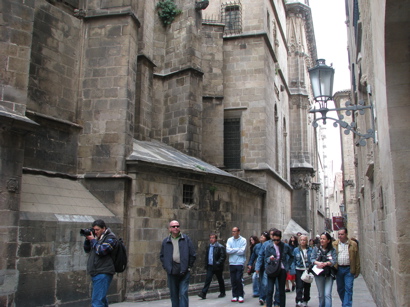
and the ornaments, like this unicorn

and the windows, especially the windows. I took a great many window photographs.

The cloister was a serene place full of shrines for many saints, connected around a courtyard by high-roofed walkways.
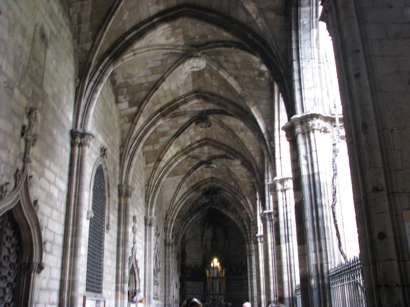
My favorite statues were up in the main sanctuary: Our Lady of Happy Childbirth was a particularly lovely one, and I lit a candle for a friend there.
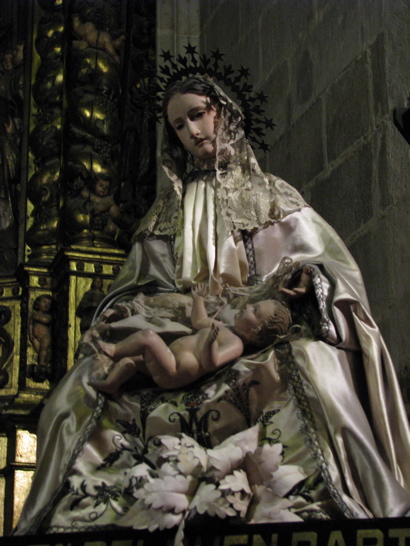
My pictures of the famous “Black Madonna” did not come out very well.
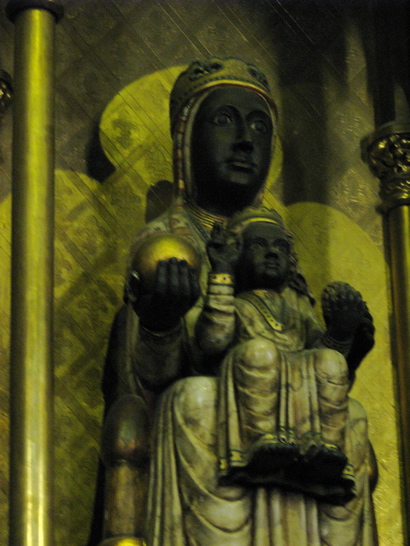
I loved the Immaculate Conception shrine very much.
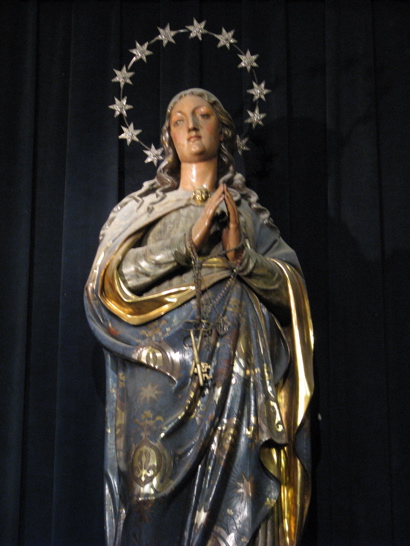
After a very long time, I tore myself away from the cathedral. I wandered over to La Rambla, the wide pedestrian walkway lined with flower vendors and shops.
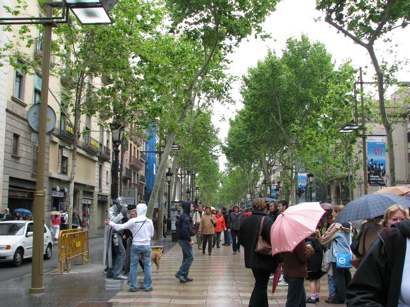
La Rambla is famous for its “living statues.” Can you spot the one in this photo?

It was hilarious to watch him startle scrutinizing passersby by whipping out his pistol when they came close.
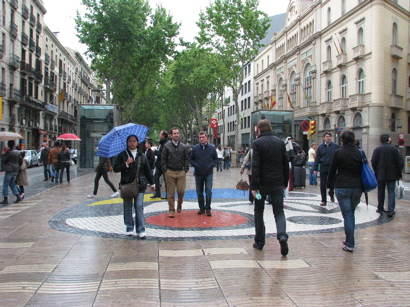
More art! A Miro mosaic in the sidewalk.

Outdoor cheese stall down a side street.

I was amused, later, to find this same photo (only better) in a guidebook. Because, you know, I didn’t read any guidebooks until I was on the plane coming home. Brilliant!
The rest of my Gothic Quarter pictures begin here at Flickr.
After my Saturday morning trip to Sagrada Familia, I returned to the hotel for lunch. Yes, it’s true. I went to a foreign country and ate in the same place for every single meal except one. What can I say? The food was free. And the strawberry-gum-flavored ice cream. Sure, we had to pick from the same three entrees for lunch and dinner each day. And the next day? Slight variations on the same three entrees from the day before. Also: if you should grow weary of the so-rare-it-glistens meat after three or four meals in row and dare to ask for your duck to be cooked WELL DONE this time, be warned that such a request will deeply offend the chef and when your duck is served, twenty minutes after the rest of your party is finished eating, you will stick your fork into the pleasingly char-browned surface and IT WILL BLEED ALL OVER YOUR PLATE. If you think I am exaggerating, ask Jock. He was sitting next to me and will testify that within seconds my asparagus was floating in a pool of blood. And boy was the waitress annoyed with me when she came to clear my plate and saw that I hadn’t eaten a single bite. The chef had labored hard to create such a masterful deception of cooked fowl.
But I digress. Eating at the hotel day after day wasn’t about the food; it was about the company. I may have mentioned once or twice that we really really enjoyed the people we were hanging out with. But by Saturday night, yes, Scott and I were ready to sample some other Spanish cuisine. Any cuisine. The Dunkin Coffee in the subway was starting to sound pretty appealing.
Our plan to slip away for a romantic dinner at the shore Friday night had been thwarted by the awards ceremony, but Saturday there was no mandatory loud music to listen to while nibbling appetizers and pretending we were having tapas. We got a recommendation from the lovely girl at the check-in desk and hopped a cab for the beach. And by “hopped a cab” I mean stood outside the hotel for 25 minutes wondering if any cabs, in fact, ever stopped there.
Finally, about five minutes after our reservation expired, one did.
I tried to take pictures out the cab window and wound up with a classy series of photos I like to call White Dots on Black, or Reverse Dice. Which is appropriate since the restaurant was down near a strip of casinos.

Ooh, pretty!
This was our restaurant. Even the name was romantic. Shall we sail away together on La Barca Del Salamanca by the light of the moon, the moon?

See, there really is a moon!
The restaurant door was hung with fairy lights, and really it was all too beautiful and goosebumpy for words. Boat, a moon, and the Mediterranean! We are people who order pizza once a week—at a minimum—so this was shaping up to be an incredibly special evening.
Under the fairy lights, past a quaint wooden screen—and we found ourselves in a school cafeteria.
That’s what it sounded like, at least. One big echoing room packed with people, and oh my goodness, the noise! Bright lights, tables squished so close together they formed long rows, like in a hospital cafeteria. Except hospital cafeterias don’t usually have cats running around, and we saw at least one tabby slinking in and out around people’s feet under the chairs.
We were seated next to a party of Irish holidaygoers, two young couples in Barcelona just for the weekend. And by “seated next to” I mean I was bumping elbows with Connor the accountant from Galway. “We’ll be old friends by the end of the night,” he said, and truer words nivver were spoken. (That’s a test to see how many of my readers have actually read my books. Ha!)
Scott and I had come to this restaurant in search of a good paella. And boy howdy did we find it. It was served in a skillet the size of my first car, loaded with shrimp and clams and scallops and calimari. We nearly killed ourselves trying to eat it all. I offered to share with Connor and Co., but they had filled up on the sea bass.
After dinner, the waiter plopped some bottles on the table alongside a platter of almond cake. “Invitation of the house,” he said, and we totally thought it was a treat because he liked us so much, but later we learned that many Catalonian restaurants serve free schnapps after the meal.
The schnapps was in a whisky bottle, and we were given shot glasses. I stuck with a few sips of the Manzana liqueur, which I thought tasted like melted green apple Jolly Ranchers (in other words, that’s my kind of drink!), and Connor called them “apple drops” which sounds so much cooler than Jolly Ranchers. Scott found himself enjoying Scotch for the first time in his life, before he found out it was in fact schnapps. Which explains how he was able to down so many shots. Did I mention we were drinking with Irishmen? There was much toasting to be done. Turns out the two women were sisters who grew up obsessed with Little House on the Prairie. We had much to talk about. Slainte!
Now, I’ve actually jumped right over half a day in this post, because there was another Gaudi expedition in between the raw duck and the paella. But that is for another post. And another day. My husband brought me home my favorite Haagen Dazs Dulce de Leche ice cream, and it is calling my name.
Or maybe that’s my two-year-old.
Friday night there was a party at the hotel for all us comic-convention guests. It was an award ceremony in Spanish for Spanish artists, and there was a lot of very loud music and giant video screen and inscrutable finger foods. Certain shameless ingrates tried to slip away from this party for a romantic evening out, just the two of them, all alone in a foreign country halfway around the world from the five children they had never ever before left for more than a night, but these ingrates were caught and picked up by the scruff of the neck and deposited back in the middle of the very loud music and the fish-flavored rice.
Honestly, the nerve of some people.
After the party, a group of artists went out to a club, but these particular ingrates had had their fill of shouting small talk in a noisy setting, so they hatched an alternative plan with certain British chums and slipped stealthily downstairs to the piano bar. Unfortunately it turned out the British chums hadn’t actually been able to hear the whispered plan above the party din, and the smiling and nodding and exclamations of “Brilliant!” was more of a general amiability and not so much an assent to The Secret Plan. The two ingrates, therefore, found themselves alone in the empty and quiet piano bar; and though the British lads were missed, quiet solitude was not at all a distressing turn of events.
Eventually the charming Peter Bagge strolled in and joined the contented couple for a drink and some fine conversation. Just another lovely evening in the Barcelona Catalonia Plaza.
The next morning saw Scott back at his desk in the editors’ corner of the convention hall. I fitted my camera out with fresh batteries and headed out to see, at long last, Gaudi’s cathedral-in-progress, La Sagrada Familia—the Temple of the Holy Family.
This enormous church was begun in the 1880s and is still under construction. There is a long way to go. I walked in thinking it was a pity about all those cranes and all that scaffolding, and I sure hope they get this thing finished up soon. I walked out believing in my bones that it doesn’t matter how long it takes to finish. The work is part of the artistry. The making is part of the magic. This is a magnum opus taking shape before our eyes, like the raising of the great cathedrals of old, when generations of craftsman devoted their lives to creating something magnificent for the glory of God. Here, too, we have families of artisans in which the craft is passed down from grandfather to father to son: sculptors and stonemasons, glassworkers and engineers. It’s a grand work, an epic work: and there is love going into every inch of the cathedral. Every small detail has significance, has been pondered and planned. You could spend a lifetime ‘unpacking’ the symbolism.
Gaudi was quite a young and relatively untried architect—but already his genius and vision was obvious to his peers—when he was hired to replace the cathedral’s original designer, one year into construction. The crypt had already been dug, but the rest of the design is Gaudi’s, every arch, column, window, and spire. Through the decades that followed, even when he was taking commissions to design other buildings, the work of Sagrada Familia remained close to his heart. In 1914, with most of his loved ones dead and gone, he devoted himself full time to the church. He knew he would not live to see its completion and wanted to leave a complete and thorough record of plans and models for those who would follow him. He poured the last 12 years of his life into this labor of love, and even though many of his plans were destroyed in a fire during the Spanish Civil War ten years after his death, his plaster models and other records survived.
He envisioned an edifice with 18 spires rising high above the city, the tallest (and as yet unbuilt) tower high enough to be seen from anywhere in town—and yet a little bit smaller than Montjuic, the mountain from which I first glimpsed Sagrada Familia’s spires. Man’s creation, Gaudi said, ought not to pridefully surpass God’s.
The church will have four facades. Two of them are completed, and a third seemed well along, but it was hidden behind scaffolding. The fourth and final facade will be the Glory Portal and Gaudi’s vision for that entrance is breathtaking. The two facades that I saw were on opposite sides of the building: the Passion Facade and the Nativity Facade. Both are stunning and it’s hard to know where to begin talking about them.
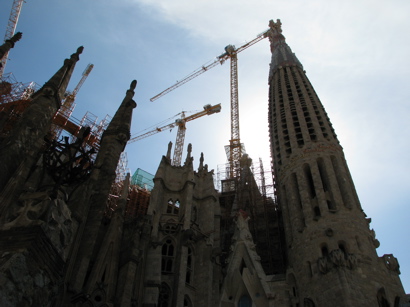
Here’s how I saw it first: head tilted back in awe.
You will not be terribly impressed by my photos. There are better images all over the internet. I really need to go back: that first day I was too blown away to think like a photographer.

Nativity facade, left and center porticos. (Left is the Joseph portico; center is the Jesus portico. Why oh why didn’t I get a shot of the Mary one?)
(Because I didn’t know until later what I was looking at. I read all about the church on the plane coming home.)
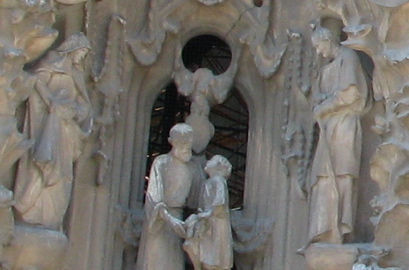
Detail, Joseph facade. Jesus brings his foster-father a wounded dove; his grandparents St. Anne and St. Joachim look on. Note the rosaries hanging beside them. There is a wealth of beautiful detail here. The Nativity facade portrays scenes from the birth and young life of Christ.
Gaudi intended the cathedral to be a visual Bible of sorts, portraying the entire gospel on its stone walls. And one of the strange things for me was to be viewing these scenes in the midst of a comic book convention: I’d had the same sensation in the mural rooms at the Museum the day before. All of this is sequential art, stories unfolding in panel after panel, just like modern-day comics. Gaudi’s “stories” even contain a good deal of text, like comic-book captions. Words are carved all over the stone, ribbons and banners proclaiming “Hosannah” and “Gloria in excelsis deo” and such.
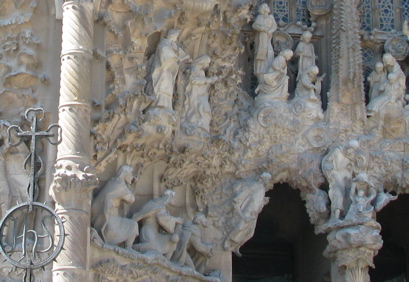
Scene from Jesus portico, over the main doors. Joseph and Mary present the infant Jesus while the Magi and angels look on. The big column on the left separates the Joseph and Jesus porticoes. There’s another on the Mary side. At the base of these columns are two large tortoises: one a sea turtle and one a land tortoise, the former facing the sea and the latter facing the mountains, to signify unchangingness and eternity.
Also note the JHS symbol inside the crown of thorns on the wrought-iron cross.
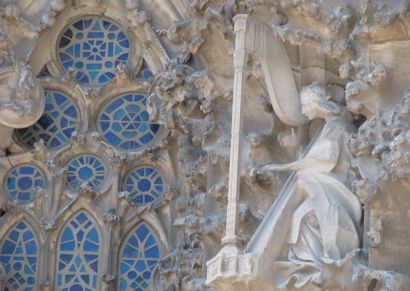
Another rosary is draped over the top of the window.
You see how I could easily keep this up all day. There is too much to show and tell!
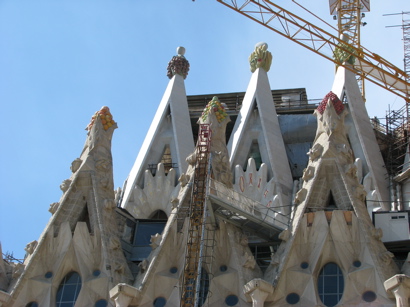
Atop these spires are bunches of fruit made of sparkling Venetian glass—fruit to symbolize abundance and fertility. Gaudi’s work—all of it, not just this cathedral—is full of images and motifs from nature. The gargoyles on this church, instead of being monsters and demons, are reptiles and amphibians, creatures associated with evil. Gargoyles are meant to siphon rainwater off the roof; Sagrada Familia’s gargoyles are salamanders, serpents, lizards, frogs—all facing downward, fleeing the Mary symbol on the “Star of the Sea” spire which is yet to be built.
There will be 18 towers in all: 12 for the apostles, 4 taller ones for the four gospel-writers, 1 taller still for Mary, and the tallest of all for Jesus. At a projected 170 meters, it will be taller than the great cathedral in Cologne, Germany, which I had the good fortune to visit at age 14—and, as I mentioned above, one meter shorter than Montjuic.
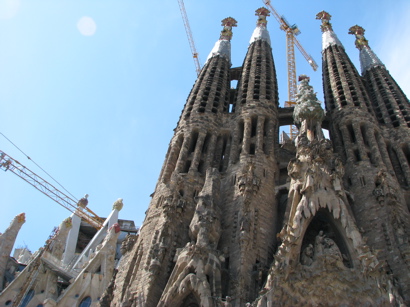
Four of the apostle spires above Nativity portico.
The church is shaped like a Latin cross, rounded at the top end. The cross arms are the Nativity and Passion Porticos, facing east and west respectively. The Glory facade will face south. The north end, the nave end, is dedicated to Mary with a special chapel.
That end, though, was the one covered by scaffolding. I walked around to the west side and paid my entrance donation to visit the interior through the Passion portico.

The Passion facade. I listened to an audio recording by the sculptor who designed these figures. He said he didn’t want to try to imitate or duplicate Gaudi, but rather to create something in keeping with Gaudi’s vision which was also true to his own work, his own vision. My pictures come nowhere near to conveying the power and solemnity of these stark, sorrowful figures.

The skulls at Christ’s feet really got to me.

Judas betrays Jesus with a kiss. Note the serpent uncoiling from beneath Judas’s robe. On the wall behind them is a crytogram; can you figure it out? To the right, the scourging at the pillar.

Here’s a better look at the cryptogram.
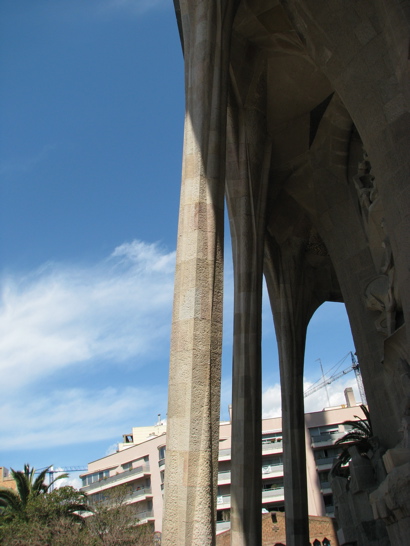
The columns holding up this portico are like bones.
There is a particularly horrific depiction of the slaughter of the innocents. I was sure I had a photo, but I can’t find it. You can view an image here, but be warned: it’s pretty brutal. Um, I guess that would be obvious from the subject matter. That poor mother’s anguish will be burned into my heart forever.
Oh my, this is a very, very long post, and I haven’t even gone inside yet. And inside: oh, the beauty! But I think I will end this now. Perhaps I’ll write about the interior later. For now, let me leave you with just a few last pictures: a rose window from inside, and columns rising on the Glory facade without.
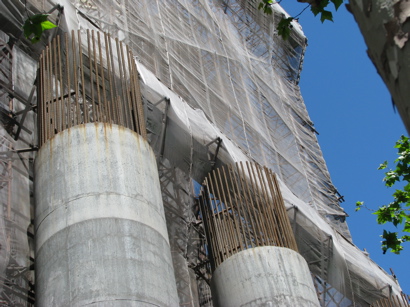
Art in progress.
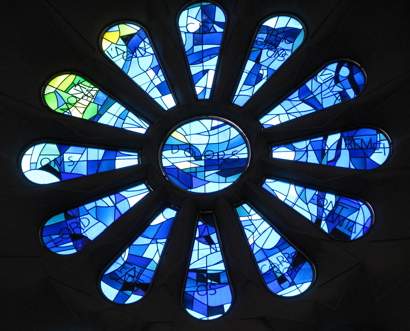
Art in full flower.
Thursday evening, after I returned to the hotel from my first art museum visit, I met Scott in the lobby with a crowd of artists and writers. That evening set the tone for the rest of the trip: each night we gathered in the piano bar around seven or eight (there was a piano but no pianist) for lively conversation until moving en masse to the dining room at 9:30. Dinner stretched to midnight every night, and then the party usually moved back to the piano bar until the wee hours of the morning. I loved the opportunity to swap stories with all these other creative folks.
I guess it was Thursday at dinner that we first met Andy Diggle and Jock, the former a British writer and the latter a British artist who have collaborated on many projects. Jock is the studio-mate of one of Scott’s very favorite artists (and people), Lee Garbett, who pencils Midnighter. Scott was bummed that Lee wouldn’t be at the con (but for the best of reasons; he had a one-week-old son at home), but was looking forward to meeting Jock and Andy, whose work he loves. The four of us hit it off right away, and the truth is we liked them both so much that I’m in danger here of gushing in the most embarrassing manner. So let me just say that they are two of the nicest, smartest, funniest guys I’ve ever met (reminded me of Scott’s brothers, if Scott’s brothers were artsy and had cool accents), and we loved them to pieces and I’m dying to meet their wives and children, and I hope our families will be best friends forever.
(Good thing I decided not to embarrass myself with the gushing.)
Friday morning we meant to get an early start. Scott didn’t have to start portfolio review until 5—his one free day of the week. But when dinner isn’t over until 12:30 in the morning, the words “early start” are relative. It was close to eleven, I think, when we finally set off for the elevator, intending to seek out some Gaudi architecture. After almost 48 hours in Barcelona, it was high time.
My plan was to visit La Sagrada Familia first. But in the elevator lobby we bumped into Tim Sale and his friend and translator Diego, who sold us on a section of town called Park Güell (we thought he was saying Parkway, so now you know how to pronounce it).
He mentioned a salamander sculpture, and I pulled out my guideboook and pointed to the cover. “This one?” “That’s it,” he said. He told us we could get there by subway and there would be a short walk “up to the Park.” With moving staircases, he added. We hopped into the elevator and stopped by the front desk to ask for subway directions. There’s a station directly outside the hotel, and the line we needed makes a stop there. The hotel clerk told us which stop to take. There would be signs, he said, pointing the way to Park Güell.
A nice Cockney man (whose father, he told us, lives in Alaska) helped us navigate the ticket machine and subway gates. We found our train and enjoyed the ride. Once out of the subway, we did indeed see the signs pointing us toward the Park. But it seems Diego, who is by all accounts a brilliant linguist, one of the best translators in all of Spain, had nevertheless omitted some tiny little words from his description: he should have said “up A VERY STEEP MOUNTAIN to the Park.” And those moving staircases? Half of them were out of order. We huffed and puffed our way to the top—
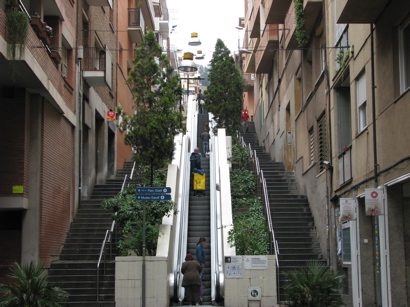
Going up
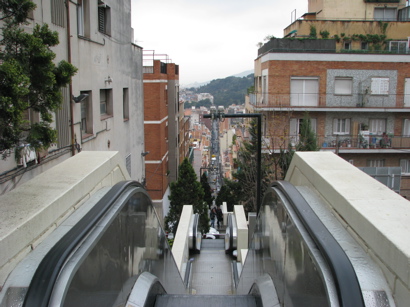
Looking down
—and were rewarded with excellent views of the city.
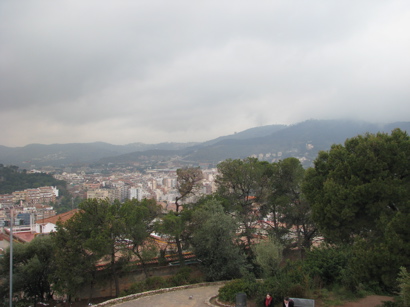
At the summit of the hill are stone steps leading up to three stone crosses.
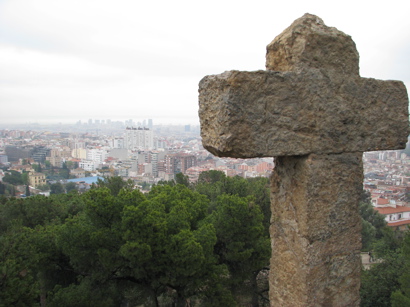
From this perch we could see the spires of La Sagrada Familia, and the green lanes of the avenue known as La Rambla leading down to the sea. It had begun to rain by this time, but only a drizzle. I had my pricey pink umbrella. Scott got wet.
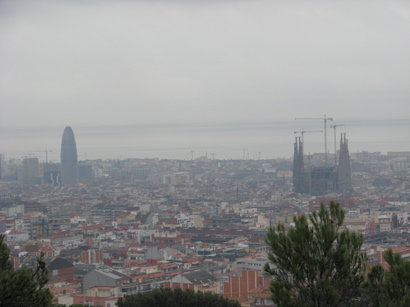
La Sagrada Familia on the right, and the building called Torre Agbar on the left
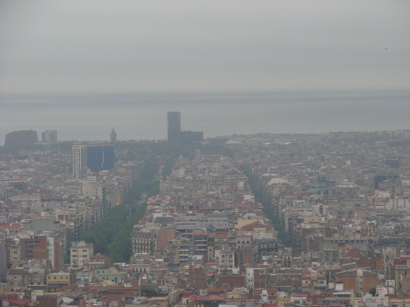
The wider green belt on the left is La Rambla, a pedestrian walkway lined with shops.
From far below us floated up the strains of trumpet music: the song selections amused me. Raindrops Are Falling on My Head, Singing in the Rain…I wondered if the musician was playing at a restaurant somewhere on the streets below.
Despite the rain, this was a beautiful place—but where was the Gaudi? After some uncertainty over which path to take, we tramped through dripping woods and down a dirt lane. A ripple of brightly colored mosaic railing told us we’d found the right place. The path took us to a wide, flat terrace with the undulating mosaic rail curving round.
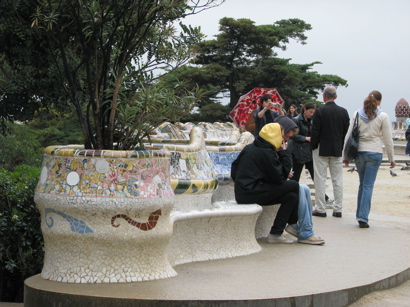
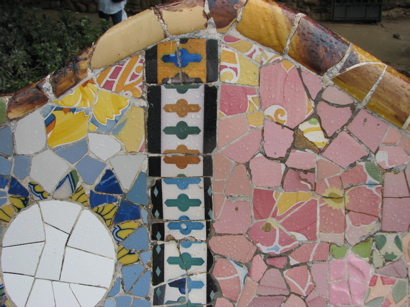
And there too we found the trumpet player: a busker leaning against the curved wall just out of the rain. I dropped a euro in his trumpet case, and he smiled wide and thanked me. He was from Cuba, he told us, and has a cousin in California. He’s been in Barcelona for six months. “Do you know the song I was playing?” he asked me, and I said, “No, but when I was up on the hill I heard you playing “Raindrops Are Falling on My Head,” and it made me smile.” He grinned broadly and said, “You knew!” Then he said he’d play a song just for us, a little Sinatra. It was “Fly Me to the Moon,” which I sing to my kids all the time. I laughed and clapped and he bobbed his trumpet up and down in reply, adding a little blast at the end to startle some children who were seeming a little too interested in his heap of change.
We walked to the edge of the terrace and looked down upon two buildings that were unmistakably Gaudi designs. A tall blue-and-white mosaic spire rose from a house right out of fairyland, or maybe candyland. Gaudi’s use of mosaic to ornament his structures is at once whimsical and breathtaking. (Scott, reading this, snorts: “Fairyland? More like Dr. Seuss on acid.”)
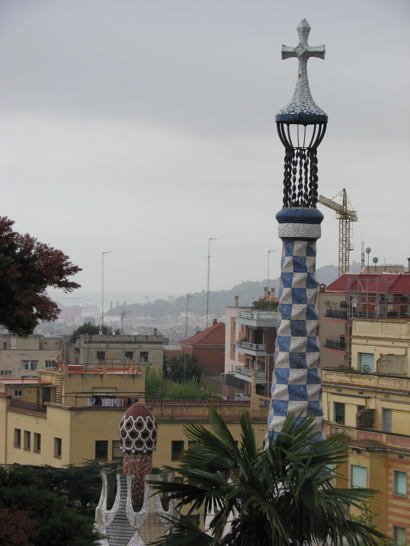
I wish the colors were true in these photos. The overcast day dulled the pictures, but even through the drizzle the real mosaics gleamed bright and vivid as jewels. Rich blues, greens, golds, crimsons…Everywhere we looked, we gasped. Every tiny detail is original and magical.
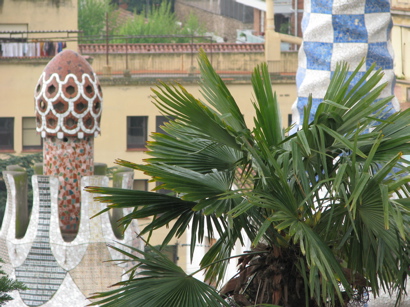
Scott thought the blue-and-white spire looked made of fabric.
Eventually we tore ourselves away from the view and followed some more steps down to a lower level, where we discovered we’d only just begun to see the wonders of Park Güell.
Below the terrace we were standing on is a…I don’t know what to call it. Domed area with many columns. The terrace forms its ceiling. That ceiling is like nothing else on earth. Concave circles side by side, like an Escher painting, circles done in mosaic. Most of them are a sort of iridescent tile, with here and there a dazzlingly bright ring of jewels.
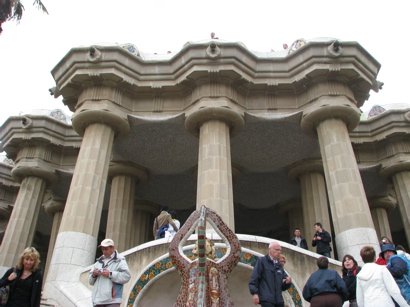



Another staircase leads down, presided over by my old friend the salamander.

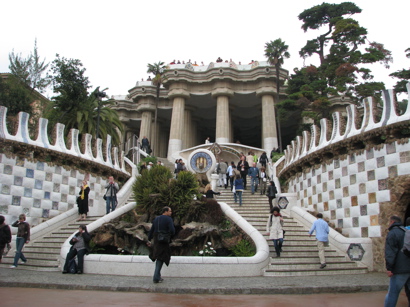
The main staircase. The big walls on either side are ornamented with the most beautiful tiles that have been broken and reassembled as mosaics in a repetition of the undulated surface used all over the park. Each colorful square has a concave shape, irresistible to the hands and soothing to the eyes.

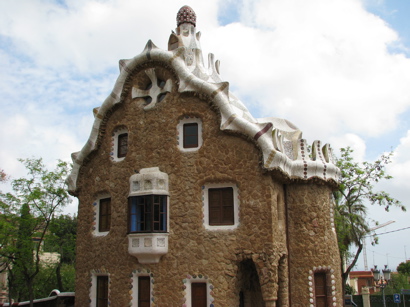
You can find much better pictures on Flickr and elsewhere. My camera batteries died partway through this visit, and the light was against me, so I didn’t get the perfect shots I wanted. But it’s a gorgeous place. It was intended to be a housing development of sorts, designed by Gaudi. The development never got off the ground, but later Gaudi bought one of the houses himself—not one of the ones in these pictures, which aren’t full-scale houses; there are two other buildings on the park grounds, designed by other architects, and it was one of these that Gaudi bought to live in with his elderly father. We toured it, but they didn’t allow photos. Not that it mattered for my camera at that point. I recharged them in the room, though, for the next day’s big outing: La Sagrada Familia.
More Park Güell pictures on Flickr
While Scott worked his evening portfolio review shift, I headed back up the many many steps to the Palau Nacional.
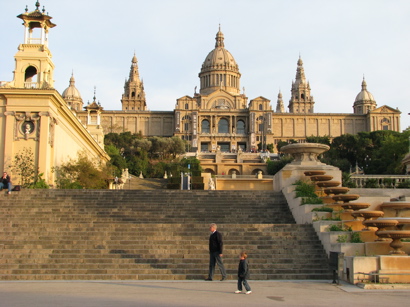
Don’t be fooled. These are only some of the steps.

The admissions clerk told me my ticket was valid for two days, which was a good thing because that first evening, I only had time to visit one floor. I began with the upper story, the modern art wings. This museum, the National Art Museum of Catalonia, is one of the best art museums I’ve ever visited.
The building is a work of art in its own right.

Ceiling.
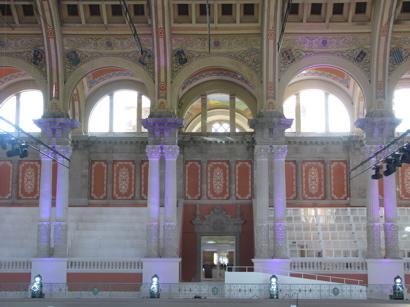
Auditorium.

Main gallery, looking up toward the dome.

Main gallery.
I wish I could post images of all the paintings and sculpture that blew me away. Artists new to me were Nicolau Raurich and Lluis Rigalt, both of whom had a way of painting luminous skies that reminded me of Maxfield Parrish.
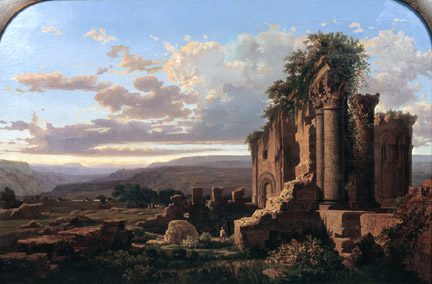
Ruins by Rigalt
I had heard of Fortuny and Joaquim Mir, but had never seen much of their work. Fortuny’s The Battle of Tetuan filled an entire wall and was overwhelming in its scope and detail. Hundreds of small stories are being played out there in the larger battle scene. I loved the wealth of detail in his Spanish Wedding, too. You can view images of these at the MNAC website, but the images (even when you click to enlarge) are too small to show off Fortuny’s genius.
There were a few small Picassos (I never did make it to the Picasso Museum, alas) and one Dali sketch. A larger Dali painting was on loan to another museum. I loved this sculpture by Llimona:
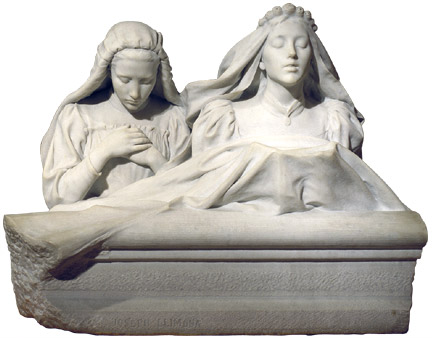
First Holy Communion
And this one by Claraso:
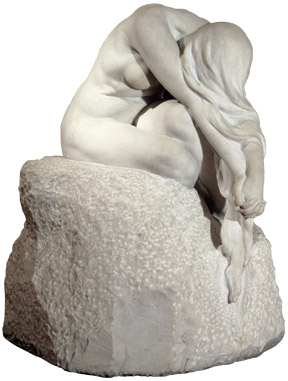
Eve
I knew my girls would love this dreamy painting by Joán Brull:
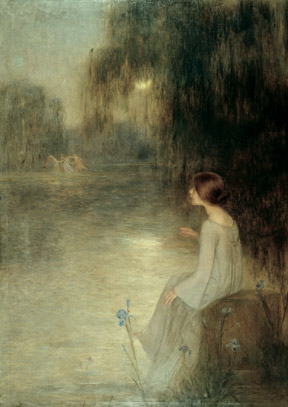
Reverie
Let me jump ahead now to Friday evening, when I returned for a few hours. This time I wandered through the rooms of religious art on the ground floor. Oh my goodness. Incredible sights to see there. Entire rooms are devoted to murals (or fragments of murals) recovered from old churches across Spain. These once vivid paintings are now faded and patchy, but you get a good sense of their majesty. The museum has replicated the size and shape of the interiors the murals once inhabited: room after room of domed ceilings and arched entrances. Hushed and full of shadows, these are solemn, contemplative spaces, illumined by scenes from the life of Christ in dusky blues and faded golds.
Other rooms contained ornate triptychs and gold-embellished paintings. The collections of Gothic and Romanesque religious art are world-famous, apparently. I can’t begin to do these collections justice, so I’m not even going to try. One image that I saw reprinted all over the place on postcards and book covers was the Christ figure from this twelfth-century altar frontal:
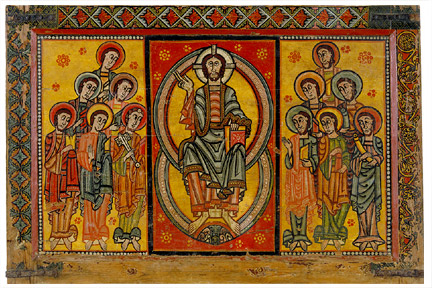
Apostles Frontal from La Seu d’Urgell
My favorite piece of religious art was this magnificent Counter-Reformation painting by Juan de Zurbarán.
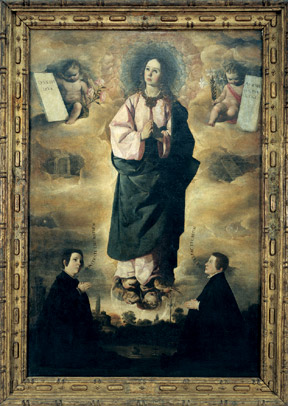
Immaculate Conception
In the bookshop I bought a museum guide that contains images of almost everything in the museum, and it’s a good thing I did, because I’d have forgotten most of it already. I hope to track down prints of some of the paintings I loved, but I have to say a preliminary search has not yielded much fruit.
I tore myself away when the museum closed at seven. I knew Scott would be just getting off his shift at the con on the avenue down below. And now comes one of the most magical moments of the whole trip. I started down the first long flight of steps, marveling at how golden and beautiful the evening was and yet a bit wistful that there was an avenue of fountains ahead of me and all of them stilled. And just then, as the stairs took me past the highest fountain—it whooshed into life. Really. It was a waterfall, and as I traveled down the next few steps, the second tier of the waterfall burst over the ledge in a glittering spray. A few more steps, another waterfall—the awakening of the fountains keeping pace with my steps each time. It made me laugh out loud, it was so gorgeously serendipitious. It was like I was a Disney princess. I reached the broad flat level halfway down the hill, where the huge “Magic Fountain” fills the space. A small crowd had gathered round it and as I drew near, there was a sound like the intake of breath and then shhhh, up it came, the water arcing high above our heads from dozens of jets. And not just water, but music and lights. It opened with Clair de Lune, and I was not the only person there who got choked up.
But I didn’t have my camera with me. I know, I know. I had already been up Montjuic four times by this point and thought I’d snapped everything I could possibly snap. But here’s a YouTube clip from two years ago.
Magic fountain indeed.
We woke early and ordered continental breakfasts from room service. Fresh-squeezed orange juice, ham, a sharp white cheese, very tasty. Croissants, powdered-sugar-covered pastries. Lots of dry toast, with butter and little pots of jam on the side. Red currant jam is my new favorite thing ever.
We ate, and I’m told I fell back asleep with the tray still on the foot of my bed. Jet lag is a killer. Scott had to be at the con at 11 a.m. for portfolio review and I remember swimming up out of a heavy slumber to say goodbye to him as he headed out the door, backpack over his shoulder. Then I was awake, and I got dressed, ate more jam and also some toast with jam, and took pictures of the view outside our hotel room.
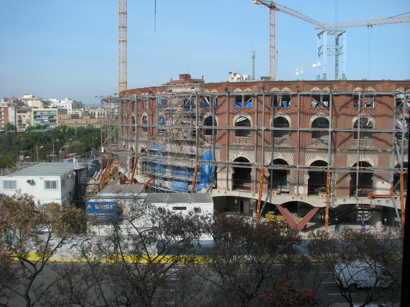
The old bullfighting arena. And cranes!
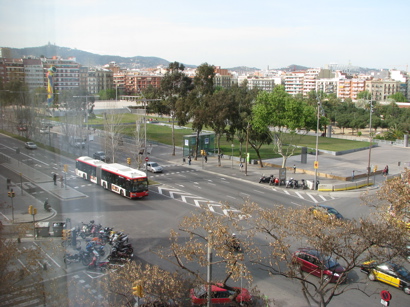
View to the left: Miró Park. Kindly excuse the glare.
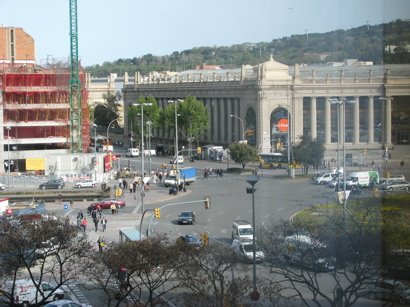
View to the right. You know this one already! The Placa Espanya. Again, forgive the glare and also my laziness in not looking up the fancy c-with-tail keystroke for Placa.
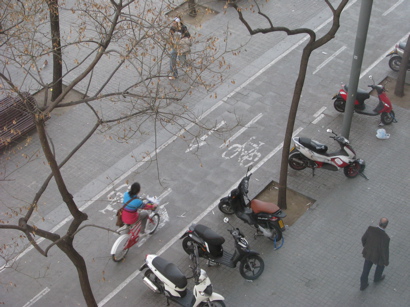
View straight down. Love that dedicated bike lane on the sidewalk! And note the red and white bike. It’s a rental, available at sidewalk racks all over the city. Our old hometown, Charlottesville, VA, was just instituting something similar when we left. It’s a genius idea.
Large chunks of the previous afternoon had passed in a blur of sleep deprivation, but somewhere in there Scott and I had discovered that internet access in the hotel cost a charming 17 euros a day, and we’d scouted out an internet cafe a block away that charged only half a euro for thirty minutes. They offered cheap phone service, too, and the hardest part of the day had been the five hours I spent waiting in the hotel lobby while Scott ran down the street to call home and check on kids and grandparents. Okay, so it was really only ten minutes. That was a loooong ten minutes, I am telling you. I think I nodded off several times. That was before our walk to Montjuic, which woke me back up a bit.
Anyway, when I was finally alert and presentable on Thursday morning (i.e. noon), I ventured out to the internet cafe and read several hilarious/heartwrenching emails from the kids. (Rose informed me that Wonderboy was sad, ouch, but that Rilla had hardly noticed I was gone: double ouch.) My mother gave a more thorough report, including the amusing tidbit that anytime she told Rilla she was going to change her diaper, Rilla would say, “No, Mommy did it.” Ha. Guess she remembered me a little.
When I came out of the internet cafe, rain was pouring down. Of course I had no umbrella. Do you think I plan ahead or something? I pulled my jacket over my head and dashed back to the hotel, where I learned that I could buy an umbrella at one of several shops around the corner the opposite direction from the internet cafe. I darted from overhang to awning and finally came upon Umbrella Heaven: a whole store devoted to them, a rainbow of umbrellas wide open on every wall and counter like something Andy Warhol might have painted if he’d been part Gene Kelly. I asked for the cheapest—and paid (gulp) a whopping 15 euros for what turned out to be the teeniest little pink umbrella this side of a Strawberry Shortcake cartoon. It covered my head but not my toes. No matter, my shoes were already soaked. It protected my camera, and that was the main thing.
I American-in-Parised my way across the rotary to the Fira de Barcelona, Palau Numero Ocho (and if you haven’t figured out by now that I am a tremendous dork, you’ll know it for sure by the end of this travelogue) and tried three different doors before I figured out how to enter the con. Yellow wristband granting entry, check. Pink umbrella under arm, check. Rained-upon hair now performing Hermione Granger impersonation, check.
The con looked like all the other comic cons I’ve seen, except in Spanish and with some quite shocking cardboard-figure art. Averting my eyes, I found the most beautiful booth in the whole convention hall.
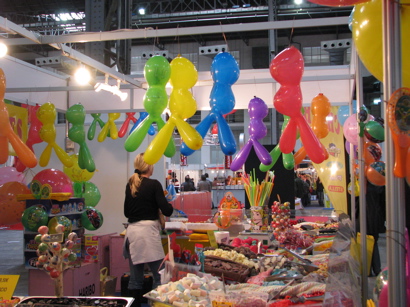

Because, yes, I am the kind of person who goes to a comic book convention and mainly takes pictures of candy.
I didn’t know where Scott’s table would be, so I asked the nearest superheroes. I must say that Clark Kent fellow is every bit as nice as he is reputed to be. Rorschach‘s a bit of a grump, though. Not that that’s news.
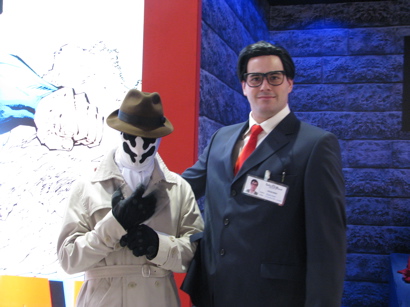
Unfortunately the Smallville high school doesn’t seem to have taught Spanish, so Clark’s direcciones didn’t help me a whole lot.
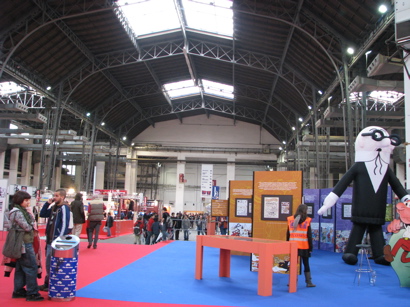
Despite his impressive spectacles and vantage point, the large gentleman on the right doesn’t know either.
Eventually I gave up trying to find him and headed back outside. The rain had stopped, and the avenue sparkled. I took a walk until it was time to return to the hotel for lunch.
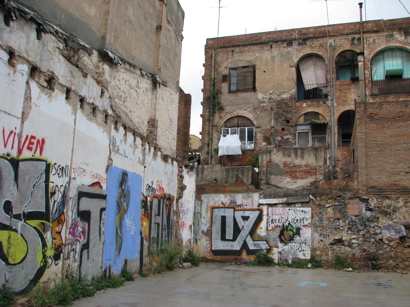
The backs of buildings are sometimes the most interesting part.
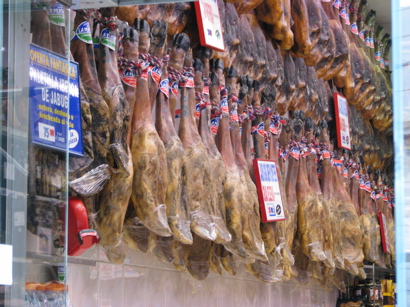
Mmm, jamón.
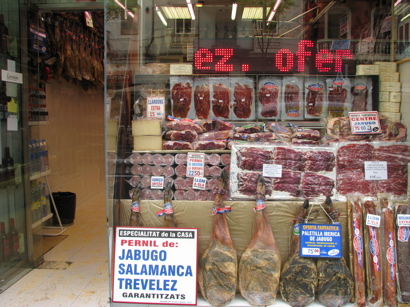
The butcher was a little suspicious of me and my camera at first, but I babbled about my niño y niñas and he warmed right up. Man I’m getting tired of looking up these fancy keystrokes.
Lunch was lots of fun that day. Scott and I sat across from Michael Golden and Tim Sale, another comics superstar. Scott had worked with him long ago and is used to hobnobbing with all these talented artists, but I’ve been out of the loop for a while. I tried not to geek out Tim too much but I am a huge Heroes fan and you know he does all the paintings for that show, plus he’s a total sweetheart. Next to me was Diana Livingstone Bruce, with her husband (that would be Mr. Ray Harryhausen) on her other side. That’s right, THE Ray Harryhausen, the pioneering film producer and stop-motion animation wizard who created the special effects for, among other classics, The Seventh Voyage of Sinbad, Jason and the Argonauts, and Clash of the Titans—which last my sisters and I watched approximately 712 times on HBO in the early 80s. That owl of Athena’s! The creepy three sisters with the one gnarly eye! Beautiful Andromeda whom I so, so, so wanted to look like except for her insanely long neck!
I gave up and geeked out.
Once again lunch lasted past 4pm, and after that I went to the art museum, and that rapturous experience should probably be its own post. Oh dear, I can see I really am going to make a novel out of this thing. I would apologize, but you come here voluntarily.
We left San Diego around midday on Tuesday, and arrived in Barcelona around midday on Wednesday. Five hours to Atlanta, nine hours to Spain, a nine-hour jump in time. Neither of us got much sleep on the plane. We knew we needed to resist the tempation to nap upon checking in at the hotel, and at first the exhilaration of being in Barcelona was enough to keep jet lag at bay. We were met at the airport by our host, David Macho, who represents a number of Spanish artists. Scott’s role at the convention was to, along with a couple of other DC and Marvel editors, meet with would-be, hopeful, and up-and-coming artists and look over their portfolios. My role was to do whatever I felt like. Not a bad deal, eh?
Another con attendee happened to be on our flight from Atlanta, along with his wife and her friend, though we didn’t know that until we met David at the airport. Tony Harris, illustrator of Ex Machina and many other titles, is a wildly popular artist and also does the most killing impersonation of Eddie Izzard impersonating Darth Vader at the Death Star canteen. I had no idea, when I squeezed between Tony and his sweet wife Stacy in the narrow back seat of David Macho’s tiny European car, that I would spend much of the upcoming week weeping with laughter over Tony’s stories.
David pointed out the sights on our way to the hotel, including prepping us for our first glimpse of the Plaça d’Espanya, a large and fairly stunning plaza bounded by the old bullfighting arena (now being renovated to become the world’s largest museum of rock) and our hotel, the Barcelona Catalonia Plaza. The Plaça contains a giant fountain (turned off at the moment, alas) and the two 154-foot tall red-brick Venetian Towers which stand imposingly at the foot of Queen Maria Cristina Avenue. On either side of the towers are large buildings with splendid facades, one of which was the site of the comic con. At the end of the avenue, partway up the hill called Montjuïc, is the Palau Nacional, home of the National Art Museum of Catalonia. Much more on that later.
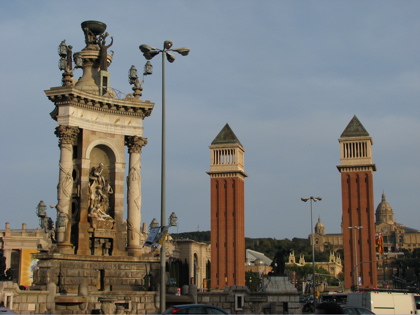
The fountain and Venetian towers, with the Palau Nacional in the distance
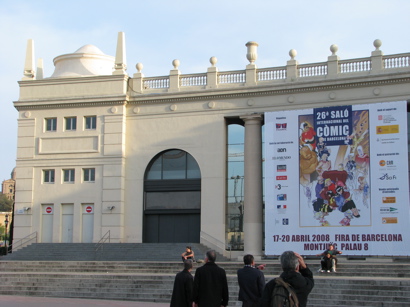
The Fira de Barcelona, site of the con
David was right: we were all pretty blown away by the sight of the Plaça, the towers, the long avenue stretching away toward the mountain with that magnificent building at the top.
By the time we got checked in, it was almost 2pm: time for lunch. Lunch and dinner was provided for us every day in the hotel restaurant. A long table filled the back room, and we were joined there that first day by the Harrises, David Macho and his assistants, and several other comic book artists and writers. We met underground comics superstar Peter Bagge and his family, and the revered artist Michael Golden, a comics legend whom I had met several times long ago during my honeymoon year in New York City, was a wry and jovial presence. Lunch that day included a delicious white bean “fisherman” stew, with a tomato broth and clams, shrimp, and squid. The rest of the meal was somewhat hazy, as jet lag began to get its teeth into us.
Determined to stay awake until night, as one is supposed to do to when traveling to a dramatically different time zone, Scott and I followed lunch—it was after 4pm by that point—with a walk up the avenue to the Palau Nacional. We climbed many, many steps (and rode a few escalators) to the top level and marveled at the views. Looking back down the avenue, past the long rows of hushed fountains, we could see our hotel. From one end of the terrace, we saw the ocean, and in the middle distance, the spires of La Sagrada Familia, surrounded by construction cranes. I didn’t know, then, how important that view was to become to me by the end of the week, nor how much the cranes would be part of the poetry of the place. That first day, it seemed a pity that unsightly construction machinery marred the view; I didn’t yet understand that Barcelona is a work of art in progress, and that the unfolding and ongoing nature of the creation of masterpieces is part of what makes that city so vibrant and beautiful. Its art is not static and finished: walking the streets of Barcelona is like being in the studio of a master sculptor, with astonishing pieces all around you and the greatest piece of all on the work table in the middle of the room, a figure of breathtaking beauty just beginning to emerge from the stone.
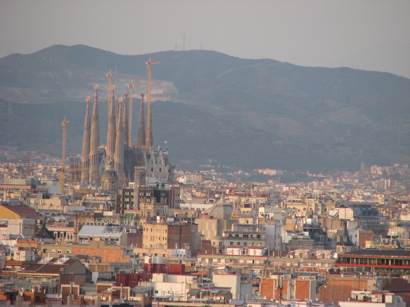
La Sagrada Familia, Gaudi’s cathedral in progress, as seen from the terrace of the Palau Nacional on Montjuic. Click to view larger image.
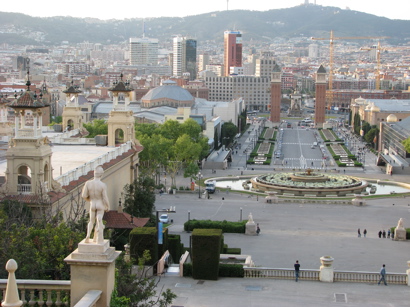
View of the Magic Fountain, Queen Maria Cristina Avenue, and Plaça Espanya from the steps of the Palau Nacional. Our hotel is the tall, cream-colored, many-windowed building just behind and to the left of the leftmost Venetian tower. In the distance, Mount Tibidabo.
That first evening, all we knew was that the view was lovely, and we were walking dead. Scott exerted heroic efforts at keeping me awake until nightfall. Dinner was at 9:30, but there was no way we were up for that. We collapsed sometime between 8 and 9: I was too far gone to do the math necessary to convert the San Diego time on my iPod to Barcelona time. There were no clocks in the room, nor anywhere in the entire city, as far as I could tell, except the giant one on the front of our hotel.

Overheard: “If I were a troll, I wouldn’t have more than two heads.”











































































